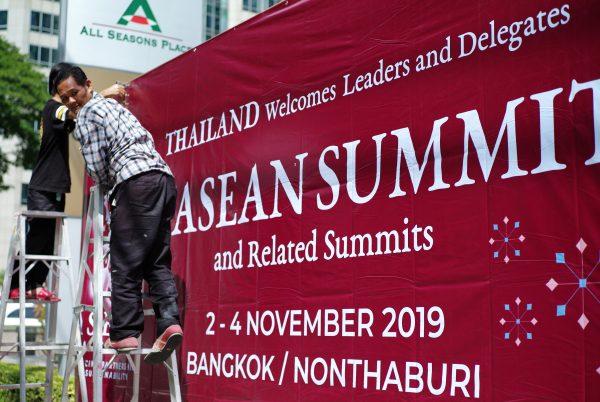In the period before the AOIP’s formulation, the two great powers with interests in the Asia Pacific set out contending views on the region. The United States and its allies — Japan, Australia and India — talked up multiple versions of a free and open Indo-Pacific. These coalesced into one point: concerns about China’s ambitions as a rising power.
China’s Belt and Road Initiative (BRI) set out another vision for the region. China’s neighbours, including ASEAN member states, welcomed the BRI as a way of enhancing connectivity through better infrastructure. But the BRI was also accused of creating debt traps and being used as a tool for Beijing’s ambitions of building a Sinocentric world.
The China–US conflict also paints a new scenario, one exemplified in US government actions against Huawei. Rather than enabling an interconnected world, technological competition led to exclusionary sanctions and disruptions in global value chains. The AOIP addresses these tensions in four areas of collaboration — maritime issues, connectivity, the UN Sustainable Development Goals and broader areas of economic cooperation.
ASEAN’s external partners have expressed their support for the AOIP and some welcome the document as ASEAN’s attempt to control the narrative. But some feel disappointed that the AOIP was unclear and lacking in specifics that could advance an ASEAN agenda.
Unlike previous ‘Indo-Pacific’ visions, the AOIP targets openness, inclusivity and ASEAN centrality. For China, there was a sense that ASEAN should have maintained its emphasis on the Asia Pacific region rather than respond to the Indo-Pacific nomenclature. China’s State Councillor and Foreign Minister Wang Yi said that China has always maintained an open and constructive attitude in regional cooperation that is consistent with the principles and ideas of the AOIP.
There are divergent views on how the AOIP should be treated in the future. Some ASEAN leaders see it as final, while others see it as a work in progress. The AOIP’s existence is thus offered polite recognition. The AOIP also acts as a common reference point, allowing ASEAN member states to engage with other countries to ensure that rules and principles are upheld.
The AOIP also has a functional influence on how ASEAN’s agenda will develop and the potential to provide a new perspective on regional connectivity and infrastructure.
National plans by ASEAN member states are the primary consideration. Aligned to these different national plans are bilateral offers and deals. National plans and bilateral assistance often have little relationship to the regional Master Plan for ASEAN Connectivity (MPAC 2025). This lack of connection between national and ASEAN-level development can diminish the prospect of providing public goods for the region.
Instead, these national and bilateral deals end up being exclusionary. An ASEAN member state may feel a greater sense of competition rather than cooperation with another ASEAN member state. The national–bilateral framework can push a country to bend towards the will of a greater power.
This need not be the case. There is an array of options for partnerships and infrastructure investments in ASEAN. Besides China’s BRI, Japan recently launched its Partnership for Quality Infrastructure scheme and the US-led Blue Dot Network hopes to have a certification scheme for projects in the region. More efforts are needed to see how these projects fit into ASEAN’s existing initiatives such as MPAC 2025.
The next priority for these projects would be to measure up the terms of the deal against the AOIP and ensure that ASEAN is consistent with its principles of openness and inclusivity. This would de-emphasise the influence that bilateral donors receive over national and regional plans. Prioritising bilateral deals from one particular donor could have consequences that affect the whole region. This could distort national development plans or affect ASEAN integration.
Looking ahead, the AOIP should be used as a lens for regional development to enable ASEAN to implement its priority areas of cooperation. Some aspects of the AOIP are already embedded in ASEAN’s activities. For example, ASEAN has had joint military exercises with both China and the United States on separate occasions. ASEAN countries have always sought to engage with all and not side with one great power over another. But in other areas of cooperation, such as connectivity and infrastructure development, more direction and clarity is needed.
There will be opportunities to examine the AOIP in relation to connectivity and infrastructure and determine whether its principles can be increasingly influential. Indonesia, an AOIP enthusiast, is likely to take the lead as it plans for a World Economic Forum on ASEAN and the Indo-Pacific Infrastructure and Connectivity Forum. Another signpost will be the ASEAN mid-term review that will evaluate ASEAN’s progress towards the ASEAN Community Vision 2025 for an integrated, peaceful and stable community.
The AOIP does not promise any new mechanism, nor are its principles new. It will act as a lens through which the principles it espouses can be viewed. In the example of connectivity and infrastructure, it can bring about a new perspective that can lead to a new way of prioritising actions.
Simon Tay is Chairman of the Singapore Institute of International Affairs (SIIA).
Jessica Wau is Assistant Director (ASEAN) at SIIA.
A version of this article appears in the most recent edition of East Asia Forum Quarterly, ‘Middle power game’, Vol. 12, No. 1.

